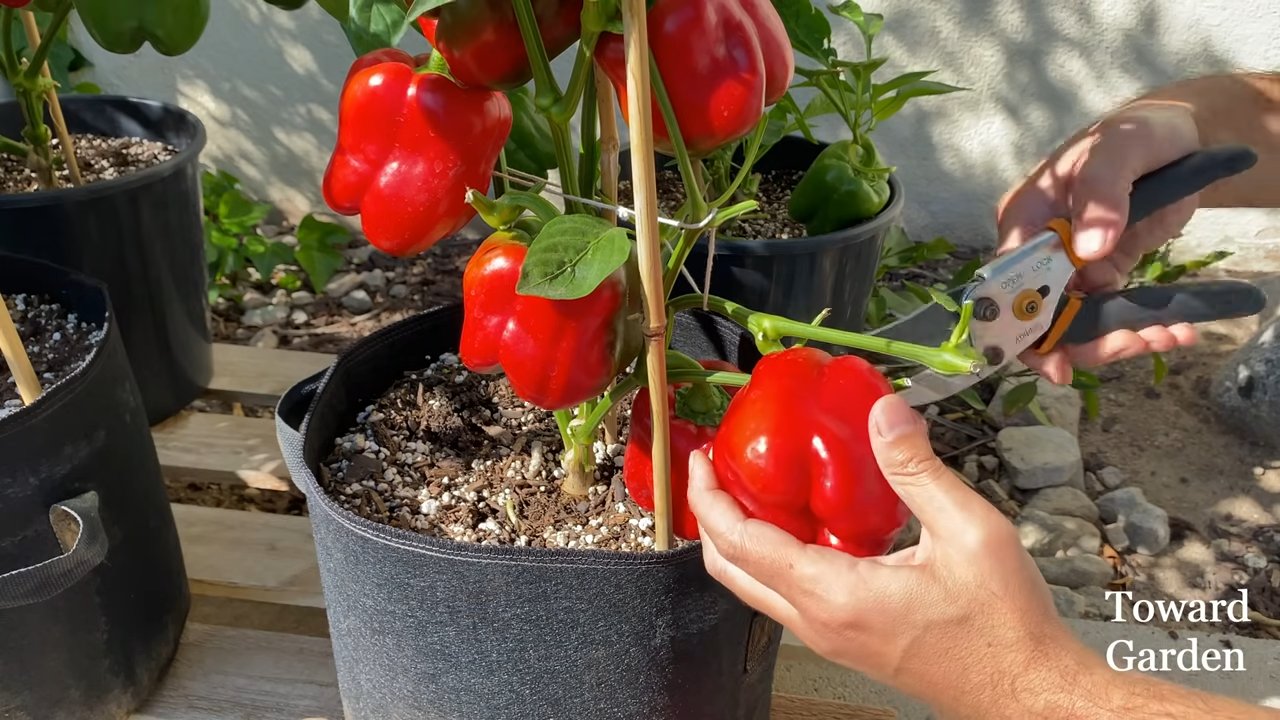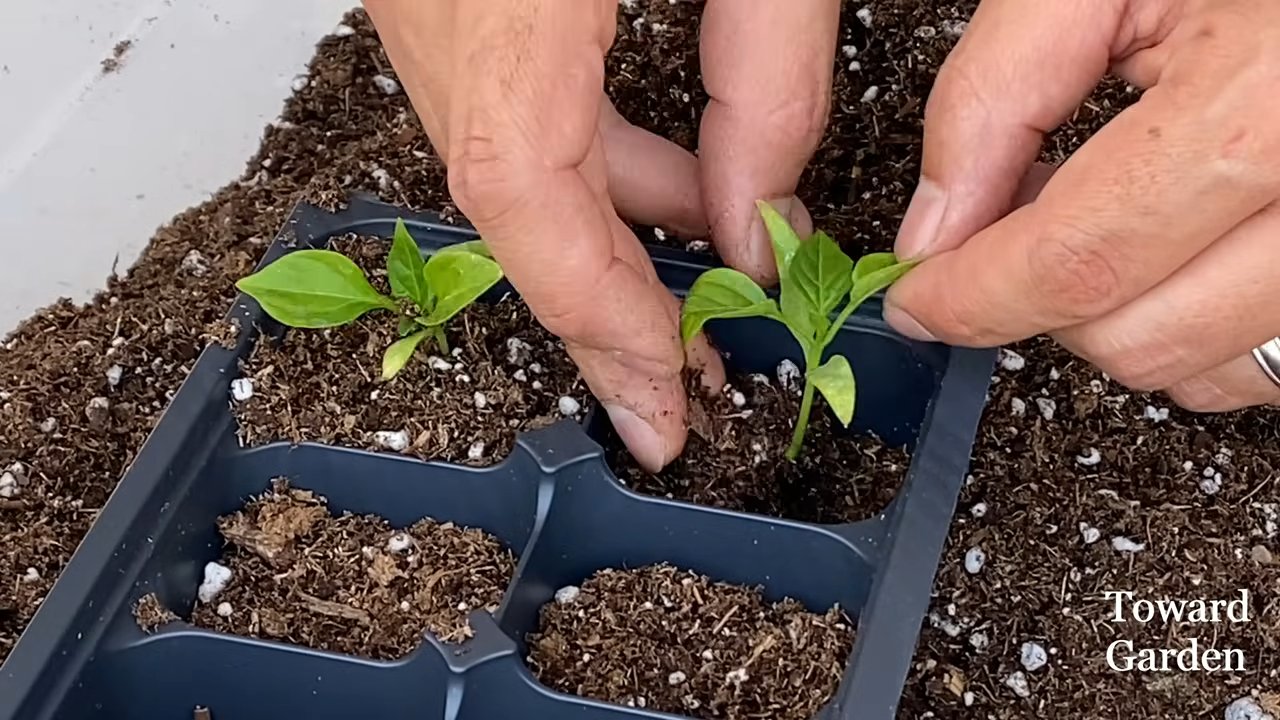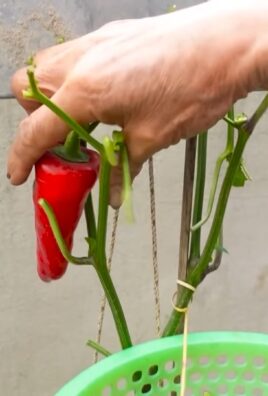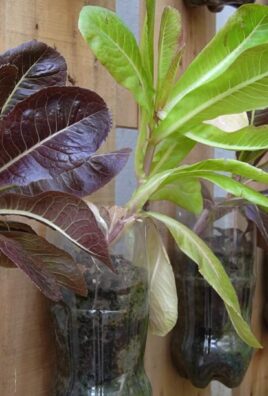Growing bell peppers in pots can be incredibly rewarding, and I’m so excited to share some simple DIY tricks that will help you harvest a bumper crop, even if you’re short on space! Have you ever dreamt of plucking vibrant, juicy bell peppers straight from your own patio? Well, dream no more! This guide is packed with easy-to-follow tips and hacks that will transform your container garden into a pepper paradise.
The practice of growing vegetables in containers dates back centuries, with evidence suggesting ancient civilizations like the Romans and Egyptians utilized pots for cultivating herbs and edible plants. Today, container gardening is experiencing a resurgence, driven by a desire for fresh, locally sourced food and a connection to nature, even in urban environments.
Why should you embrace these DIY tricks for growing bell peppers in pots? Because let’s face it, store-bought peppers just don’t compare to the flavor and satisfaction of homegrown ones. Plus, gardening is a fantastic stress reliever and a fun way to get your hands dirty (literally!). Many people struggle with growing bell peppers in pots because they don’t know the specific needs of these plants. This article will help you avoid common mistakes and ensure your peppers thrive, providing you with a delicious and colorful harvest all season long. So, let’s get started and unlock the secrets to successful container pepper gardening!

Growing Bell Peppers in Pots: A Comprehensive DIY Guide
Hey there, fellow gardening enthusiasts! I’m so excited to share my tried-and-true method for growing vibrant, delicious bell peppers right in pots. Forget needing a huge garden – with a little know-how, you can enjoy a bountiful harvest even on a small balcony or patio. I’ve been doing this for years, and trust me, the satisfaction of biting into a homegrown bell pepper is unmatched!
Choosing the Right Pot and Soil
Before we even think about seeds, let’s talk about the foundation of our pepper-growing success: the pot and the soil. This is crucial, so pay close attention!
* Pot Size Matters: Bell peppers need room to spread their roots. I recommend a pot that’s at least 12 inches in diameter and 12 inches deep. Bigger is generally better, especially if you’re planning on growing larger varieties. A 5-gallon bucket works perfectly!
* Drainage is Key: Make sure your pot has drainage holes! Peppers hate sitting in soggy soil. If your pot doesn’t have enough holes, you can easily drill a few more.
* Soil Selection: Don’t just grab any old dirt from your backyard. Bell peppers thrive in well-draining, nutrient-rich soil. I always use a high-quality potting mix specifically formulated for vegetables. You can also amend regular potting mix with compost or aged manure for an extra boost.
Starting Your Bell Pepper Seeds (or Buying Seedlings)
You have two options here: starting from seed or buying seedlings. Starting from seed gives you more control over the variety and can be more cost-effective, but it requires a bit more patience.
* Starting from Seed (Indoor):
* Timing is Everything: Start your seeds indoors about 6-8 weeks before the last expected frost in your area.
* Seed Starting Mix: Use a seed starting mix, which is finer and more sterile than regular potting mix.
* Planting Depth: Sow seeds about ¼ inch deep in small pots or seed trays.
* Warmth and Light: Keep the soil consistently moist (but not soggy) and provide warmth. A heat mat can be really helpful. Once the seedlings emerge, they need plenty of light. A grow light is ideal, but a sunny windowsill can work if it gets at least 6 hours of direct sunlight.
* Thinning: If you planted multiple seeds in one pot, thin them out to the strongest seedling once they have a few true leaves.
* Buying Seedlings:
* Choose Wisely: Look for healthy seedlings with sturdy stems and vibrant green leaves. Avoid plants that are leggy, yellowed, or have signs of pests or diseases.
* Hardening Off: Before transplanting your seedlings (whether you grew them yourself or bought them), you need to “harden them off.” This means gradually exposing them to outdoor conditions over a period of 7-10 days. Start by placing them in a sheltered spot for an hour or two each day, gradually increasing the time and exposure to sunlight and wind.
Transplanting Your Bell Pepper Plants
Okay, your seedlings are ready to face the world! Let’s get them into their permanent pots.
1. Prepare the Pot: Fill your chosen pot with your well-draining potting mix, leaving a few inches of space at the top.
2. Dig a Hole: Dig a hole in the center of the pot that’s large enough to accommodate the root ball of your seedling.
3. Gently Remove the Seedling: Carefully remove the seedling from its container, being gentle with the roots. If the roots are tightly bound, gently loosen them with your fingers.
4. Place the Seedling: Place the seedling in the hole, making sure the top of the root ball is level with the surrounding soil.
5. Fill and Water: Fill in the hole with potting mix, gently firming the soil around the base of the plant. Water thoroughly until water drains out of the bottom of the pot.
Caring for Your Bell Pepper Plants
Now comes the ongoing care. This is where you’ll really see your plants thrive!
* Sunlight: Bell peppers need at least 6-8 hours of direct sunlight per day. Choose a sunny location for your pots.
* Watering: Water deeply whenever the top inch of soil feels dry to the touch. Avoid overwatering, as this can lead to root rot. I usually water every 2-3 days, but it depends on the weather.
* Fertilizing: Bell peppers are heavy feeders, meaning they need a lot of nutrients. I like to use a balanced liquid fertilizer every 2-3 weeks. You can also use a slow-release fertilizer at planting time. Look for a fertilizer that’s specifically formulated for vegetables.
* Support: As your bell pepper plants grow, they may need support to prevent them from toppling over, especially when they’re loaded with fruit. You can use stakes, tomato cages, or even tie them to a trellis.
* Pruning: Pruning isn’t strictly necessary, but it can help improve air circulation and encourage fruit production. I usually remove any suckers (small shoots that grow from the base of the plant) and any yellowing or damaged leaves.
* Pest and Disease Control: Keep an eye out for pests like aphids, whiteflies, and spider mites. You can usually control these with insecticidal soap or neem oil. Also, watch out for diseases like blossom-end rot (caused by calcium deficiency) and fungal infections. Proper watering and good air circulation can help prevent these problems.
Dealing with Common Problems
Even with the best care, you might encounter a few challenges along the way. Here’s how I tackle some common issues:
* Blossom-End Rot: This is when the bottom of the pepper turns black and leathery. It’s usually caused by a calcium deficiency, which can be due to inconsistent watering or poor soil. Make sure you’re watering regularly and consider adding calcium to the soil (bone meal or eggshells work well).
* Aphids: These tiny pests can suck the sap out of your plants, causing them to weaken and yellow. Spray them with insecticidal soap or neem oil. You can also try blasting them off with a strong stream of water.
* Whiteflies: Similar to aphids, whiteflies are small, white insects that feed on plant sap. Use the same control methods as for aphids.
* Lack of Fruit: If your bell pepper plants are flowering but not producing fruit, it could be due to a lack of pollination. You can hand-pollinate the flowers by gently shaking the plant or using a small paintbrush to transfer pollen from one flower to another. High temperatures can also inhibit fruit set.
Harvesting Your Bell Peppers
The moment you’ve been waiting for! Harvesting your bell peppers is the most rewarding part of the process.
* Timing: You can harvest bell peppers at any stage of maturity, depending on your preference. Green bell peppers are less ripe and have a slightly bitter taste. Red, yellow, and orange bell peppers are fully ripe and have a sweeter flavor.
* How to Harvest: Use a sharp knife or pruning shears to cut the pepper from the plant, leaving a small stem attached.
* Storage: Store harvested bell peppers in the refrigerator for up to a week.
Choosing the Right Bell Pepper Variety
There are so many different bell pepper varieties to choose from! Here are a few of my favorites for growing in pots:
* ‘Yolo Wonder’: A classic green bell pepper that’s reliable and productive.
* ‘California Wonder’: Another popular green bell pepper with thick walls and a mild flavor.
* ‘Golden Bell’: A beautiful yellow bell pepper that’s sweet and flavorful.
* ‘Red Knight’: A compact red bell pepper that’s perfect for small spaces.
* ‘Mini Bell’: These small, colorful bell peppers are great for snacking and salads.
Extra Tips for Success
Here are a few extra tips that I’ve learned over the years:
* Rotate Your Crops: Don’t plant bell peppers in the same pot year after year. Rotate them with other vegetables to prevent soilborne diseases.
* Use Mulch: Mulch helps retain moisture in the soil and suppress weeds. I like to use straw or wood chips.
* Water in the Morning: Water your bell pepper plants in the morning so the foliage has time to dry before nightfall. This helps prevent fungal diseases.
* Don’t Be Afraid to Experiment: Gardening is all about learning and experimenting. Don’t be afraid to try new things and see what works best for you.
Growing bell peppers in pots is a fun and rewarding experience. With a little bit of care and attention, you can enjoy a bountiful harvest of delicious, homegrown peppers. Happy gardening!

Conclusion
So, there you have it! Growing bell peppers in pots isn’t just a possibility; it’s a rewarding and accessible way to bring fresh, vibrant flavor right to your doorstep. We’ve explored the key steps, from selecting the right pot size and soil to providing adequate sunlight and consistent watering. But why is this DIY trick a must-try?
Firstly, it offers unparalleled convenience. Whether you have a sprawling garden or a tiny balcony, container gardening allows you to cultivate bell peppers regardless of your space limitations. Imagine stepping outside your kitchen and harvesting a perfectly ripe bell pepper for your next meal – that’s the power of growing bell peppers in pots.
Secondly, it grants you greater control over the growing environment. You can easily move your pots to chase the sun, protect them from harsh weather, and amend the soil as needed. This level of control translates to healthier plants and a more bountiful harvest.
Thirdly, it’s incredibly satisfying. There’s something deeply fulfilling about nurturing a plant from seed (or seedling) to fruition. Watching your bell peppers grow and ripen is a testament to your care and dedication, and the taste of homegrown produce is simply unmatched.
But don’t stop there! Experiment with different varieties of bell peppers. Try growing colorful bell peppers like purple, yellow, or orange alongside the classic green. You can also explore companion planting by adding herbs like basil or marigolds to your pots, which can help deter pests and attract beneficial insects. Consider adding a small trellis or stake to support your bell pepper plants as they grow taller and heavier with fruit. This will prevent them from toppling over and ensure they receive adequate sunlight.
For those looking to maximize their yield, consider fertilizing your bell pepper plants regularly with a balanced fertilizer specifically formulated for vegetables. This will provide them with the nutrients they need to thrive and produce abundant fruit. Remember to follow the instructions on the fertilizer label carefully to avoid over-fertilizing, which can damage your plants.
We encourage you to embark on this gardening adventure and discover the joy of growing bell peppers in pots. It’s a simple, rewarding, and delicious way to connect with nature and enjoy fresh, homegrown produce. Don’t be afraid to experiment, learn from your mistakes, and most importantly, have fun!
Now, we want to hear from you! Have you tried growing bell peppers in pots before? What tips and tricks have you learned along the way? Share your experiences, photos, and questions in the comments below. Let’s create a community of passionate gardeners and inspire others to embrace the joys of container gardening. Your insights could be invaluable to someone just starting out. So, get your hands dirty, plant some seeds, and let’s grow together! Remember, the best way to learn is by doing, so don’t hesitate to give **growing bell peppers in pots** a try. You might be surprised at how easy and rewarding it can be.
Frequently Asked Questions (FAQ)
What is the ideal pot size for growing bell peppers?
The ideal pot size for growing bell peppers is typically between 5 to 10 gallons. A 5-gallon pot is generally sufficient for smaller bell pepper varieties, while larger varieties will benefit from a 10-gallon pot. The larger the pot, the more room the roots have to grow, leading to a healthier and more productive plant. Ensure the pot has adequate drainage holes to prevent waterlogging, which can lead to root rot.
What type of soil should I use for growing bell peppers in pots?
Use a well-draining potting mix specifically formulated for vegetables. Avoid using garden soil, as it can become compacted in pots and hinder drainage. A good potting mix will retain moisture while allowing excess water to drain away, providing the ideal environment for bell pepper roots to thrive. You can also amend the potting mix with compost or other organic matter to improve its fertility and drainage.
How much sunlight do bell peppers need when grown in pots?
Bell peppers require at least 6-8 hours of direct sunlight per day to produce a good harvest. Choose a location that receives plenty of sunlight throughout the day. If you live in a particularly hot climate, you may need to provide some afternoon shade to prevent the plants from overheating. If you don’t have access to enough natural sunlight, you can supplement with grow lights.
How often should I water my bell pepper plants in pots?
Water your bell pepper plants regularly, especially during hot and dry weather. The soil should be kept consistently moist but not waterlogged. Check the soil moisture by sticking your finger about an inch into the soil. If it feels dry, it’s time to water. Water deeply, allowing the water to drain out of the drainage holes. Avoid watering the foliage, as this can promote fungal diseases.
What kind of fertilizer should I use for bell peppers in pots?
Use a balanced fertilizer specifically formulated for vegetables. Look for a fertilizer with an NPK ratio (nitrogen, phosphorus, potassium) of around 5-10-5 or 10-10-10. Fertilize your bell pepper plants every 2-3 weeks during the growing season. Follow the instructions on the fertilizer label carefully to avoid over-fertilizing, which can damage your plants. You can also use organic fertilizers like compost tea or fish emulsion.
How do I protect my bell pepper plants from pests and diseases?
Inspect your bell pepper plants regularly for signs of pests or diseases. Common pests include aphids, whiteflies, and spider mites. You can control these pests with insecticidal soap or neem oil. Common diseases include blossom end rot, which is caused by calcium deficiency, and fungal diseases like powdery mildew. Ensure adequate calcium levels in the soil and provide good air circulation to prevent fungal diseases.
How long does it take for bell peppers to mature when grown in pots?
Bell peppers typically take 60-90 days to mature from transplanting, depending on the variety. The time to maturity can also be affected by environmental factors like temperature and sunlight. Be patient and continue to provide your plants with the care they need, and you’ll be rewarded with a bountiful harvest of delicious bell peppers.
Can I grow bell peppers indoors in pots?
Yes, you can grow bell peppers indoors in pots, but you’ll need to provide them with adequate light. Place them near a sunny window that receives at least 6-8 hours of direct sunlight per day, or supplement with grow lights. You’ll also need to ensure good air circulation and maintain a consistent temperature.
What are some common problems when growing bell peppers in pots and how can I fix them?
Some common problems include blossom end rot (calcium deficiency), stunted growth (lack of nutrients), and pest infestations. Blossom end rot can be prevented by adding calcium to the soil. Stunted growth can be addressed by fertilizing regularly. Pest infestations can be controlled with insecticidal soap or neem oil.
Can I overwinter my bell pepper plants in pots?
In some climates, you can overwinter your bell pepper plants in pots by bringing them indoors before the first frost. Cut back the plants to about 6 inches tall and place them in a cool, dark location. Water sparingly during the winter months. In the spring, gradually acclimate the plants to outdoor conditions before transplanting them back into their pots.




Leave a Comment